 |

| |
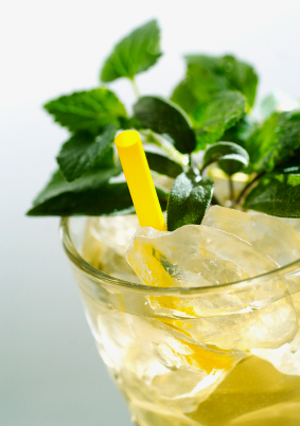
Teas’ Tea in Green White, a blend of Japanese green tea and Chinese white tea. Photo by Tomo Jesenicnik | IST. |
| WHAT IT IS: Fine bottled teas in green, a green-white blend and oolong. Most people would drink them iced, but they actually can be heated in the microwave (in a cup) for those who want hot tea without brewing. Available in 16.9-ounce individual bottles and 2-liter size. |
| WHY IT’S DIFFERENT: Taking what may be possibly the highest-quality tea that ends up in a bottle and combining it with their patented brewing process (read more about it in the full review) produces an outstanding product. We could not brew iced green teas this good at home. |
| WHY WE LOVE IT: Crisp and profoundly authentic tea flavor. Whether it’s a pure tea (Green, Green White, Hoji or Oolong) or a flavored tea (Jasmine, Lemongrass, Rose), everything is brewed to perfection. |
| WHERE TO BUY IT: ItoEn.com. |
|
|
 |

Teas’ Tea From Ito-En:
Iced Is Very Nice
June is National Iced Tea Month. Iced tea once meant deep-brewed tea and clinking ice cubes. Then came the Snapple generation, which turned the genteel beverage into a riot of fruit flavors. Two decades later, some companies are putting a new snap into the category by offering elegant bottled teas brewed with quality tea leaves. You can still get sweetened, fruit iced teas—perhaps no one does them better than Inko’s White Teas—and we love the unsweetened bottled teas in 15-plus fruit flavors from The Republic Of Tea.
But to celebrate the glorious taste of the tea leaf, we think the best brew in a bottle is the unsweetened green tea line, Teas’ Tea from Ito-En, Japan’s largest tea company. For those who don’t savor green tea, iced tea shows it in a new, crisp way—and with Ito-En’s patented brewing process, there’s not a drop of bitterness. Teas’ Teas are as refreshing as the coolest glass of glacier water—with all those antioxidants thrown in for good measure. Whether you want your tea pure green, blended with white tea, flavored with jasmine, lemongrass or rose, a robust roasted hoji or a glorious oolong (the one non-green tea variety), this is a calorie-free, carb-free celebration of great tastes. If the teas make you feel poetic (not such a stretch), enter the haiku contest on the website. Whether or not your poetry wins, whenever you discover something this good, you’re a winner. Bring some 2-liter bottles to parties and barbecues instead of wine.
- Click here to read the full review below. (If your e-mail client does not support anchor links, scroll down.)
- Read reviews of more of our favorite gourmet teas in THE NIBBLE online magazine.
- See the Table of Contents of the June issue of THE NIBBLE, plus the back issues archive and our most popular articles.
- All of the Top Pick Of The Week newsletters are permanently archived on TheNibble.com, in chronological order and by product category.
|
THE NIBBLE does not sell the foods we review
or receive fees from manufacturers for recommending them.
Our recommendations are based purely on our opinion, after tasting thousands of products each year, that they represent the best in their respective categories. |
Learn More About Japanese Tea
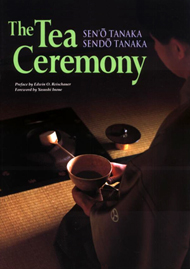 |
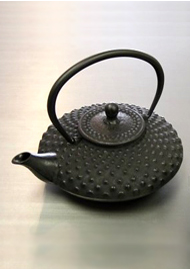 |
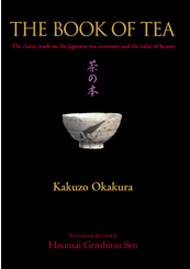 |
| The Tea Ceremony, by Seno Tanaka. A beginner’s introduction to the tea ceremony. You will learn not only about the tea ceremony, but will gain a perspective on everything Japanese, from gardens to architecture. The author is the grandson of the founder of the Japan Association of the Tea Ceremony. $19.80. Click here for more information or to purchase. |
Japanese Cast Iron Tea Pot With Matching Cups. A lovely example of the traditional cast-iron teapots known in Japan as tetsubin, this pot with its delicate, hand-cast, raised design is not only prized as a collectible, but also brews 20 ounces of tea perfectly. A perfect “tea for two” with the two matching cups, and beautifully gift boxed. $55.99. Click here for more information or to purchase. |
The Book of Tea: The Classic Work on the Japanese Tea Ceremony and the Value of Beauty, by Kakuzo Okakura. Written 100 years ago by a Japanese expatriate to make sense of Japanese culture for an English audience, this is the history of tea and its preparation, and the Zen esthetic in which cha-do (“the way of tea”) makes sense. $13.57. Click here for more information or to purchase. |
Teas’ Teas From Ito En: Iced Is Very Nice
INDEX OF REVIEW
|
MORE TO DISCOVER
|
The story of Japanese tea is 1,200 years old. In 805 C.E., two Buddhist monks, Saicho and Kukai returned to Japan from China with tea plants. The caffeine enabled monks to stay alert through long meditations, and for a long time, tea was grown only within the walls of monasteries. Later, aristocrats and samurai enjoyed its benefits. It became known as a sacred, curative medicine that prolonged life. Rules evolved for drinking tea, based on the concepts of Zen Buddhism. In the mid-16th century, the tea ceremony (cha-no-yu) was formalized, incorporating ambience, accoutrements and brewing methods that honored Zen principles of spirit and soul. It had a major impact on the spiritual and aesthetic culture of Japan that endures today. While modern Japanese do not conduct a tea ceremony preceding the partaking of tea, it is a sign of culture and breeding to study the arduous ceremonial art—every mother’s wish is for her daughter to train in cha-no-yu. Today, green tea in Japan is enjoyed universally as avid coffee lovers in America enjoy their coffee: upon waking, through the day, at all meals and as a favorite refreshment.
About Ito En
More than 40 years ago, Ito En was founded to produce and sell green tea (Ito is the name of the original family, and “en” means “gardens,” after tea gardens, a name for the estates where tea is grown). It became the number one brand of loose leaf tea in Japan, the world’s largest supplier of green tea and a $3 billion company, employing upwards of 2,000 people.
But in modern Japan, the younger, active, on-the-go population sought alternatives to the time-intensive, venerable brewing of tea. Ready-to-drink tea—ubiquitously available hot or cold in vending machines—was a hit. Initially this meant the partially-fermented oolong tea: It was said to be impossible to bottle or can the unfermented green tea, because the brewed tea would oxidize when left in contact for any amount of time with the air in the can or bottle. But in 1985, Ito En revolutionized green tea by creating the ready-to-drink green tea category with a 100% naturally brewed, unsweetened, canned green tea. A unique bottling process removed the oxygen from plastic bottles and left no sediment or cloudiness, only a very sharp and clean-tasting tea. This product was considered to be so remarkable that it was named “Outstanding Product of the Year” by the newspaper Nihon Keizai Shinbun. It is drunk cold, at room temperature or microwaved in a cup, and is purchased in two-liter formats as well as single-serve.
|
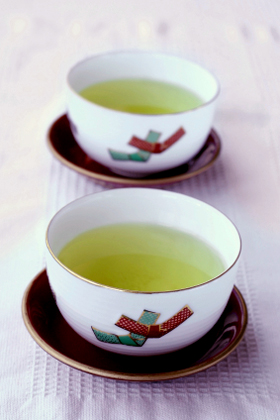
Many green teas don’t look at all green, as in the
photo above, but are a golden red-brown color, like
oolong. And, like olive oils, teas can be colored to provide “greenness.” Photo by Yoko Bates | IST. |
The company launched a flagship store on Madison Avenue in New York City in 2001, a haven for the finest loose teas (it also sells the bottled teas). It’s an opportunity to discuss tea with knowledgeable people who are passionate about tea. And there’s a superb Japanese restaurant, Kai, on the second floor.
The Health Benefits Of Tea*
Tea is the most consumed drink in the world after water, and has been used as a healthful beverage (and as traditional Chinese medicine) for thousands of years. Only recently has scientific research discovered the catechins in tea, strong antioxidants that reduce the rate of certain oxidation reactions and can counteract the damaging effects of oxygen in tissues (for more information, read our Antioxidant Glossary). Since green and white tea are not fermented, no catechins are lost to oxidation, as they are in oolong (partially oxidized) and black (fully oxidized) teas. Unfermented tea also retains more content of certain minerals and vitamins which have antioxidant potential.
Recent studies suggest that green tea may contribute to a reduction in the risk of cardiovascular disease and some forms of cancer. There is an impressive list of other potential benefits, including oral health, lower blood pressure, antibacterial and antiviral effect, ultraviolet protection, bone mineral density increase, protection against the formation of fibrous tissue, protection against nervous system degeneration and even help with weight control. However, although all the evidence from research on green tea is very promising, future studies are necessary to fully understand its contributions to human health. Green tea consumption in Western diets is quite limited compared to Japanese consumption. A Japanese might drink the equivalent of eight cups a day—an amount which has been mentioned by some researchers as optimal for realizing the full benefits of catechins.
Many Americans tried green tea after the research studies became news: Some liked it, some didn’t. As with black tea, there’s a broad spectrum of qualities and flavors of green. You might not enjoy beer if your frame of reference is Bud Light, for example, but if someone hands you a great craft beer, it could change your mind. If you’ve found green teas too vegetal or bitter (a problem caused by using boiling water—unfermented teas are delicate and should be brewed with water at 190°F, not boiling), there are other green teas that could be your “craft beer.”
|
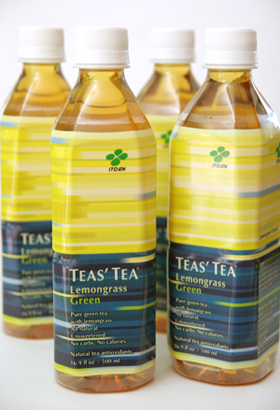
Lemongrass Green Tea: Very healthy and incredibly flavorful, this Japanese-Thai fusion flavor hits a home run. All photos of bottled tea by Naheed Choudhry.
Back to Index
|
So if you haven’t cottoned to green tea before, try one that’s brewed to perfection.
*Source: Cabrera C. and Artacho R, Giménez R., “Beneficial Effects of Green Tea,” Journal of the American College of Nutrition, 2006 Apr;25(2):79-99.
Teas’ Tea Bottled Tea Flavors
In the United States, tea is the fifth most popular beverage, following water, coffee, soft drinks and juice. Eighty percent of tea sold is bottled (iced tea), and most of that is sweetened black tea made of average-quality tea—generally broken pieces, fannings and dust. Teas’ Tea is different: unsweetened green, white and oolong teas, brewed to the highest standards to please discriminating Japanese palates by the number one whole leaf tea company in Japan. You can read more about the differences between green, white, oolong and black teas in our Tea Glossary and other articles in our Tea Section.
All green tea complements seafood, and can be enjoyed at any time as a refreshment (other serving suggestions are provided with the individual teas). The caffeine, 25mg per eight-ounce serving, is energizing (a cup of brewed coffee has about 80mg).
The all-natural teas are brewed with premium loose Japanese green tea and/or Chinese white or oolong tea, plus purified water. Ascorbic acid), which is added to preserve the color, has an added-value benefit of providing 100% or more (depending on the flavor) of one’s daily value of healthy vitamin C. The unsweetened have zero calories, carbs or fat. The company’s “natural clear” bottling technology yields a distinct clarity and draws out the natural taste of green tea.
The teas range from light to robust. Rather than present the varieties in our usual alphabetical order, we’ll do so from mild to robust.
- Pure Green (Mild)
The line begins with Pure Green tea. Aptly named, this purest of green teas has no added flavoring, allowing the clean, crisp, leafy notes to shine. Very light on the palate, with an almost innate sweetness, there is a nice, green herbal finish. We drink at least a bottle a day.
Both Pure Green and Green White (see next bullet) will complement most foods.
|
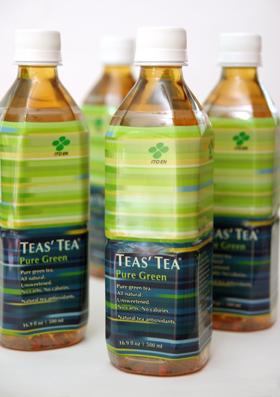
Pure Green Tea: a simply beautiful beverage—we
couldn’t ask for a lovelier iced tea. You must try it
before you leap into the rest of the line. |
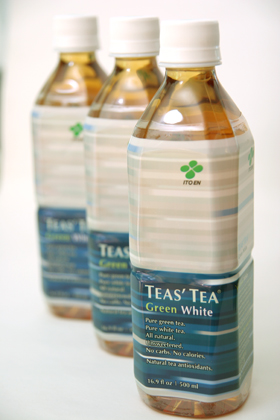
Green White Tea: the mildest flavor with the most antioxidants. |
- Green White (Mild)
Green White blends Japanese green tea with white tea imported from China. White tea is a specialty of China and India, made from the buds of the tea bush. Young tea leaf buds (not the tea leaves, but the buds) are plucked in early spring, then withered and dried in the sun (or sometimes steamed or fired) to stop oxidization, thus making it an unfermented tea.
White tea is picked when all the leaves, which are green, are still in a bud and covered with fine, silvery white hair or down—hence the name. The buds can be harvested for only a short period every spring. Because it is new growth, and there are fewer buds per plant compared to leaves, white tea is produced in lesser quantities than green or black tea, accounting for the rarity. Because new and tender buds of first flush tea must hand-picked and processed, it is costly to produce. When brewed, its flavor is delicate and subtle: It is lighter and sweeter than green tea, with a light yellow, pale liquor. According to many studies, of all teas, white tea contains the largest amount of catechins due to its youthfulness and minimum processing.
|
- Green Jasmine (Medium)
Green Jasmine is green tea that has been naturally infused with the scent of jasmine flowers, by alternating layers of jasmine flowers with the green tea leaves prior to the brewing process. Jasmine’s distinctive floral taste is both beautiful and refreshing, and makes it a favorite among many (it certainly is ours!). Some claim that jasmine tea has nerve-calming properties—but perhaps it’s just the deliciousness that makes them happy (photo below). If you’re serving it with food, pair it with more simple flavors (no complex sauces or seasonings) so the glorious floral of the jasmine can show off.
- Golden Oolong (Medium)
Golden Oolong blends fine Chinese oolong tea leaves to provide a golden color and lovely aroma of peaches and apricots that carries through on the palate. Oolong is a partially fermented tea—halfway between unfermented green tea and fully fermented black tea. Oolong is often paired with fatty, oily and fried foods, but this delicate oolong is a pleasure enjoyed all alone.
|
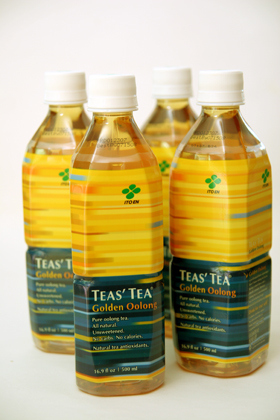
Golden Oolong Tea: delicate notes of peach and
apricot.
|
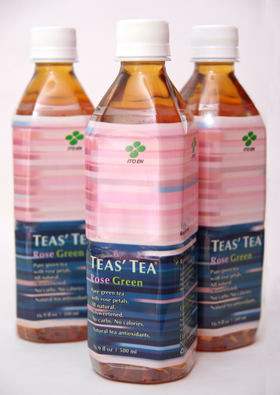
Rose Green Tea: Everything may be rosy, but this is no delicate, feminine flavor. |
- Rose Green (Medium)
Rose Green blends green tea leaves and delicately dried rose petals, which give the tea a rosy hue. Yet, far from being a rosy, floral tea, the rose petals provide the semblance of a tannin backbone to the tea. There’s only the faintest hint of rose flavor on the finish: We think that Rose Green joins Green Hoji as the most assertive of the teas. However, the pink bottles and the concept of rose tea make this flavor appealing to serve at showers and other parties, and also to tuck into the goodie bags.
- Lemongrass Green (Medium)
Lemongrass Green brews green tea leaves and aromatic lemongrass. It has so much exotic flavor, it could double as an alcohol-free cocktail! When Lemongrass Green first debuted two years ago, it was one of the most exciting products of the year. Aside from an occasional piece of artisan chocolate, it was pretty much the first marketed food product to be lemongrass-flavored.
|
Those who love lemongrass know it is rarely found outside of Thai and Vietnamese restaurants. It’s not an easy herb to procure, nor is it easy to cook with. Now, lemongrass lovers can enjoy it anytime in this stunning bottle of tea (photo above).
- Mint Green (Medium)
An infusion of real mint leaves—not mint flavor—gives this green tea a kiss of refreshing mint. Those who like a lot of mint flavor can add fresh mint to it, but it is very pleasant as is.
- Green Hoji (Robust)
Hoji means “roasted” in Japanese. Green Hoji is a roasted green tea that is popular in Hokkaido, the large island at the northern tip of Japan whose capital is Sapporo (no tiny island, it’s just slightly smaller than Ireland).
Hoji is produced using premium roasted late harvest sencha† and kuki (twig) green tea leaves (there are also black tea hojis). The roasting process for this tea is designed to meticulously preserve the natural fresh taste and aroma enjoyed from a freshly-brewed pot of hoji green tea. The nose is lightly toasty, with a bit more toastiness on the palate. While some hojis are very roasted- and smoky-tasting, this, like all Teas’ Teas, is a refined brew. It isn’t overwhelming, but can stand up to stronger flavors, hearty and roasted foods, including meats. For fun, though, taste Pure Green or Green White after you’ve tasted Green Hoji. They’ll taste like ice water.
†A green tea of delicate sweetness, mild astringency and flowery-green aroma, prepared by a method of steaming, drying and rolling called sencha. All of Ito En’s green teas are sencha.
|
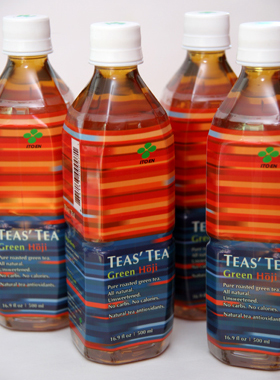
Green Hoji: a robust, “roasty” flavor makes this the
heartiest of the Teas’ Teas.
|
In addition to the 16.9-ounce individual bottles, Jasmine, Green White and Pure Green are sold in a 2-liter size that are a nice gift idea: Bring one of each to a party or barbecue instead of a bottle of wine. Toss them into the cooler for picnics or road trips. Teach teens to enjoy refreshing tea flavor: For the same price as a bottle of water, you get catechins and sophisticated flavor.
LEARN ABOUT PAIRING TEA WITH FOOD
No matter what you’re eating—from cheese to chocolate
to curry to salsa—there’s a tea to go with it. In fact, depending
on what particular cheese or chocolate, there’s a perfect tea match.
Read all about it in this highly-informative article.
|
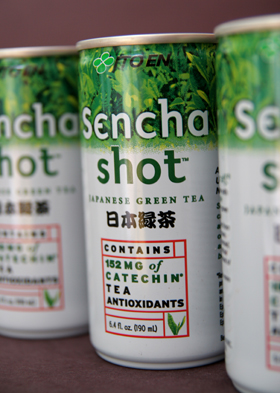
A concentrated shot of green tea packs extra flavor and energy into a pocket-size can. |
Sencha Shot
If you like green tea, you’ll love Sencha Shot, a concentrated green tea with five times the antioxidants of a regular cup (or bottle). Using premium Japanese loose tea leaves, Sencha Shot is brewed with an advanced method that yields a deep green tea taste and a higher content of natural catechin tea antioxidants—each small, 6.4-ounce can contains 152mg of catechins, which is five times more catechin than the average ready-to-drink green tea. It also includes 140% of the daily value of vitamin C.
For the past year, we’ve had a can every morning upon waking—while the coffee is brewing. The fresh, healthy taste says pure energy to us. In fact, with its concentration of caffeine—40mg of caffeine compared to 25mg per 8 ounces of regular green tea—it’s like a mild energy drink with antioxidants, but without the sugar and preservatives.
|
Ito-En also makes a line of Natural Fruit Teas: green tea naturally flavored with Apple or Blueberry; black tea naturally flavored with Apple, Apricot, Cranberry, Lemon, Mango and Peach. The company has recently introduced another line in conjunction with world-reknown integrative medicine specialist, Dr. Andrew Weil. Called Dr. Andrew Weil For Tea, products include tea bags and loose tea, plus handsome, 8.2-ounce ready-to-drink cans in Darjeeling, Green White, Gyokuro,‡ Jasmine White and Turmeric (the latter made from the spice, not tea leaves). But we’ll leave those as a tea-ser for next time.
—Karen Hochman
Updated October 2007
‡The top-grade Japanese green tea, made from tea grown on shaded bushes so the tea leaves absorb more nutrition from the fertile soil.
FORWARD THIS NIBBLE to anyone looking for delicious tea, healthy food or calorie-free food.
ITO-EN
Sencha Shot; Teas’ Tea in Golden Oolong, Green Hoji, Green Jasmine, Green White, Lemongrass Green, Mint Green, Pure Green and Rose Green
- Teas’ Tea 16.9 Fluid Ounce Bottles
Individual Flavor or Sampler Case
24-Bottle Case
$36.00
- Tea’s Tea 2-Liter Bottle
Jasmine, Green White or Pure Green
6-Bottle Case
$29.94
- Sencha Shot
30-Can Case
$45.00
Purchase online at ItoEn.com
Also available at fine retailers nationwide. Prices and product availability are verified at publication but are subject to change.
|
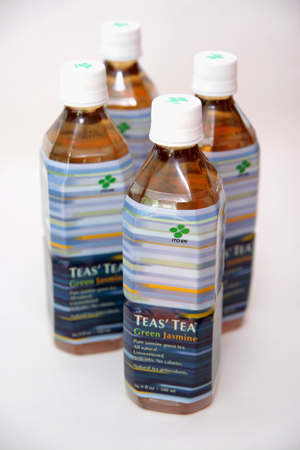
Green Jasmine Tea: a perennial favorite. |
Read more about our favorite
teas and other beverages in
THE NIBBLE online magazine.
|
Check Out These Other “Top Pick Of The Week” Beverages:
|
FOR ADDITIONAL INFORMATION, special offers,
contests, opinion surveys, THE NIBBLETM
back issues archive, product gift-finder, links to our favorite
food websites, and the ability to nominate your favorite nibbles,
visit www.TheNibble.com.
Do you have friends who would enjoy THE NIBBLE?
Click here to send them an invitation to sign up for their own copy. |
ABOUT THE NIBBLE. THE NIBBLE™, Great Food Finds™, is an online magazine plus newsletters about specialty foods and the gourmet life. It is the only consumer publication and website that focuses on reviewing the best specialty foods and beverages, in every category. The magazine also covers tabletop items, gourmet housewares, and other areas of interest to people who love fine food. This e-mail from the editors features the Top Food Pick of the Week. You can read the complete magazine and past issues at TheNibble.com.
To unsubscribe, send an e-mail to Editors(at)TheNibble.com.
To contact us with comments or suggestions, click here. If you received
this from a friend but would like to subscribe directly, go to www.TheNibble.com.
© Copyright 2004-2026 Lifestyle Direct, Inc. All rights
reserved. All information contained herein is subject to change at any time
without notice. All details must be directly confirmed with manufacturers, service
establishments and other third parties. The material in this e-zine may not
be reproduced, distributed, transmitted, cached, or otherwise used, except with
the prior written permission of Lifestyle Direct, Inc.
|
 |
|
 |















